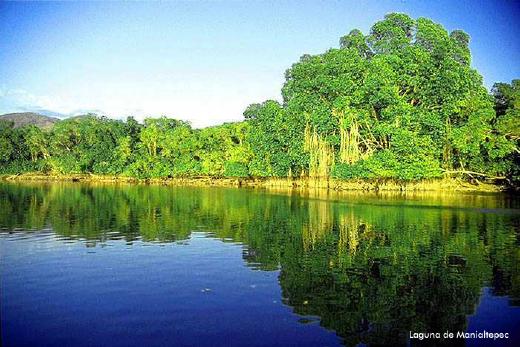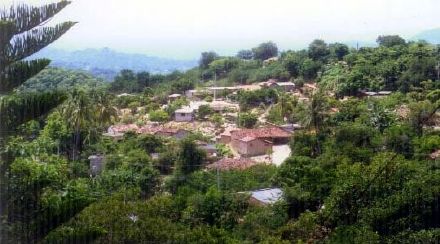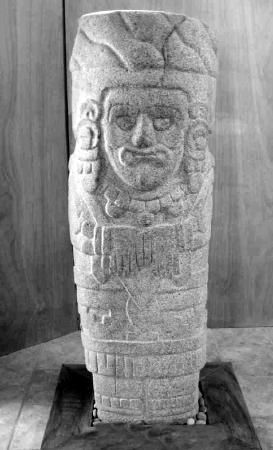

 Tranquil Manialtepec Lagoon, a short 15-minute drive from Puerto
Escondido, is home to an astonishing variety of bird and animal life and
magnificent displays of tropical vegetation.
Tranquil Manialtepec Lagoon, a short 15-minute drive from Puerto
Escondido, is home to an astonishing variety of bird and animal life and
magnificent displays of tropical vegetation.
It's a popular spot for eco-excursions. The mangrove forests are an amazingly productive ecosystem; the roots nurturing the crabs, shrimps and mussels that attract a wide variety of fish species, that, in turn, draw the birds and other wildlife.
(March is your final opportunity this season to tour with Canadian ornithologist Mike Malone, who knows the lagoon as well as anyone. Book through Dimar Travel or your hotel.)
But when night falls on Manialtepec Lagoon and all the conditions are right, there are even more magical sights to be seen.
Manialtepec's waters are a veritable soup of tiny organisms: algae, protozoa, eggs, larvae and so on, known collectively as plankton.
One form of plankton gets particularly active as the waters heat up. It's called cyanobacteria, a single-celled algae containing chloroform and a blue substance which gives off an eerie phosphorescent glow when disturbed by currents.
At night, the thousands of fish darting through the waters leave streaks like falling stars, and the wake of a motor launch looks as though it has been illuminated by powerful floodlights. If you swim in the lagoon, the droplets fall from your skin like a shimmering shower of sparks.
It's a remarkable and highly recommended experience. Before planning an evening trip, check with the tour operators or the resort areas at the lagoon to determine that the phosphorescence is still happening; the phenomenon disappears as suddenly, and as mysteriously, as it begins.
(We generally think of the Coast Highway as a north-south road, but head toward Acapulco from here and you're moving almost due west.)
San José Manialtepec lies just beyond the lagoon. Here you can rent horses for a leisurely ride through beautiful country along the Manialtepec River to Atotonilco Hot Springs, an ancient ceremonial center for the Chatino Indians.
Roca Blanca is a lovely bay named for the guano-covered island that dominates the view. A pleasant beach to relax and enjoy fresh seafood at the palapa restaurants-- great oysters when they are in season! Get there from Cacalote, home of the famed Strangler or Lover's Trees, a variety of parasitic ficus that wraps itself around a palm tree creating fanciful and grotesque shapes and patterns.
 Beyond Rio Grande, a large and prosperous cattle town, you'll find
Santa Rosa de Lima, smaller and less-prosperous and the center of the
coastal lime groves. The friendly, country-style restaurant named Doña
is worth a trip for lunch.
Beyond Rio Grande, a large and prosperous cattle town, you'll find
Santa Rosa de Lima, smaller and less-prosperous and the center of the
coastal lime groves. The friendly, country-style restaurant named Doña
is worth a trip for lunch.
Villa Tututepec, some 15 Km off the highway, is the ancient town founded by Mixtecs who dominated the region until the colonial era and were never totally subjugated by the Aztecs. Today it is still the political center of the area, which includes the nearby Chacahua National Park lagoon and wetlands. If it has reopened, you can visit the Regional Museum to learn about Tututepec's long history and see an amazing array of artifacts including great stone stelae.
Jamiltepec is a colorful and bustling market town, where the Indian ladies from the surrounding areas come to sell their produce. It's most famous for the colonial sundials in its zocalo.
 Here mauves and purples dominate in the traditional huipiles of the
women in this region, natural dyes made from a variety of sea snail and
much valued by the Zapotecos, as well as the local Mixtec people as the
Amuzgos and other cultures.
Here mauves and purples dominate in the traditional huipiles of the
women in this region, natural dyes made from a variety of sea snail and
much valued by the Zapotecos, as well as the local Mixtec people as the
Amuzgos and other cultures.
Huazpala, or San Andres Huazpaltepec, a pleasant, mostly indigenous town, lies midway between Jamiltepec and Pinotepa Nacional.
Four Km west is Huazolo, or Huazolotitlan, in a lovely verdant valley. Huazolo is picturesque and notable for elaborate woven huipiles and carved and painted wooden animal masks and figures.
For the adventurous: Continue on this same road some 25 Km and you'll
arrive in José María Morelos, one of the coastal villages where the
Afro-Mestizo tradition, a blending of Indigenous, Old World and African
cultural elements, is most apparent. This dirt road continues to make a
loop to Pinotepa Nacional, where you can rejoin the Coast Highway.